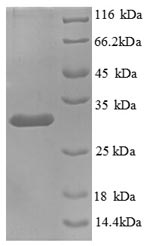In e.coli cells, the generation of recombinant Human KNG1 protein involves cloning a DNA fragment encoding the Human KNG1 protein (390-639aa) into a plasmid vector, which is then transferred into the e.coli cells. Positive cells are selected, cultured, and induced to express the KNG1 protein. A N-terminal 6xHis tag is attached to the protein. Lysis of the cells allows for the harvest of the recombinant Human KNG1 protein. The collected recombiant Human KNG1 protein is subjected to affinity purification and is identified using SDS-PAGE and subsequent staining of the gel with Coomassie Brilliant Blue. Its purity is greater than 90%.






